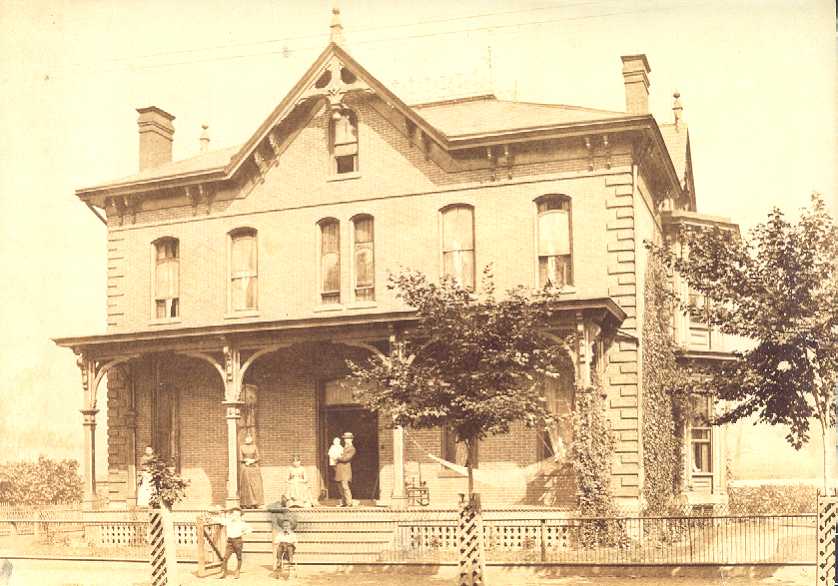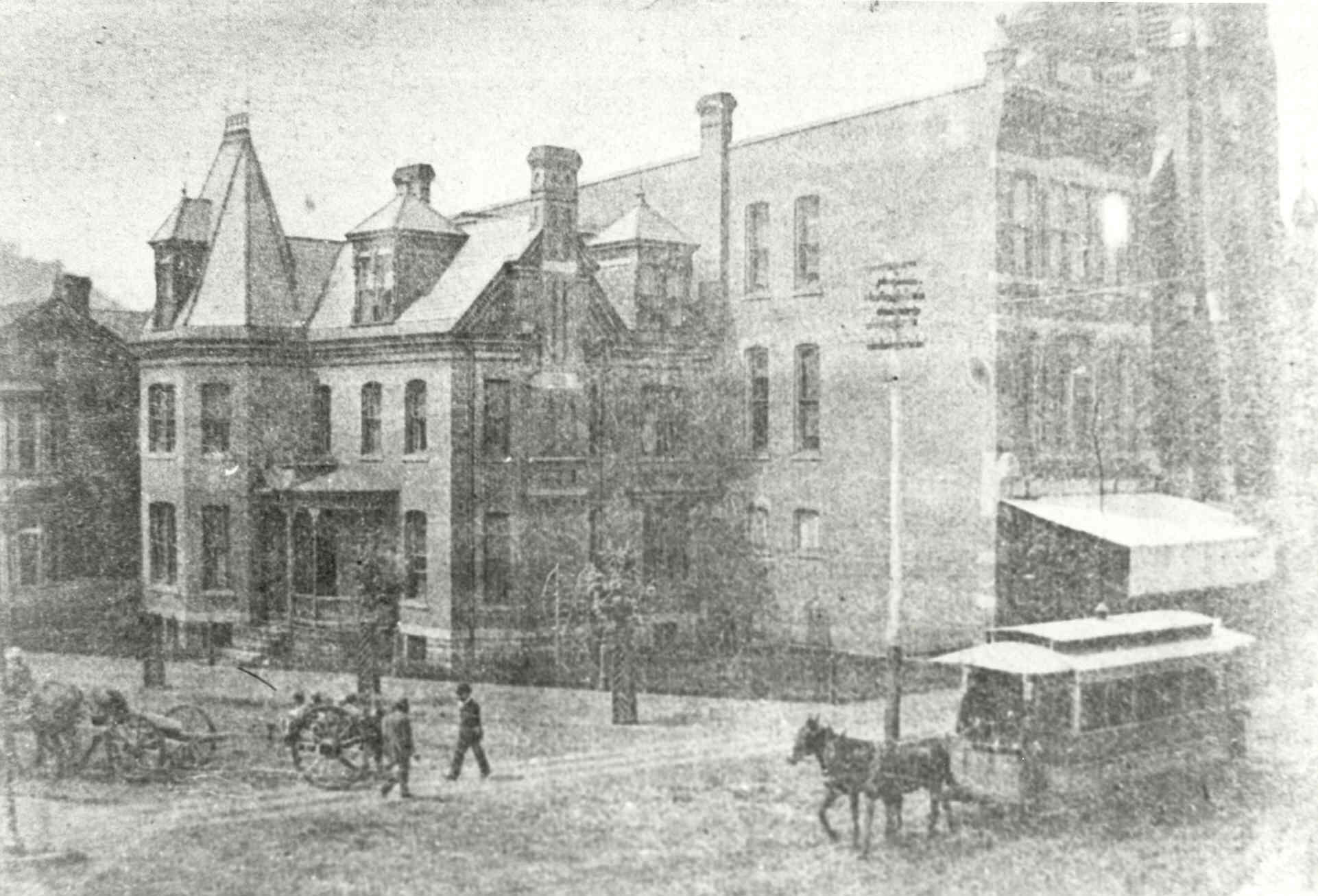The Johnson Company
Archive of Historical Photographs and Other Images
Part I - 1850-1888
Note on sources: Most images were
collected by the
author, including a wide range of newspaper clippings,
photographs
and maps
from the storage vault of the Johnstown Company (successor to the Johnson
Company
and the Johnstown
works of Lorain Steel and U.S. Steel Corporation), and personal and family photographs
graciously
shared with the author
by the families of Arthur J. and Egbert Moxham, and Charles Alfred Marshall.
Most photographs, maps, surveys,
and engineering drawings related to the Johnson Company history have now
been deposited in the archival collection of the
Johnstown Area Heritage
Association (JAHA).
Acknowledgements: Arthur James Moxham, grandson of Arthur J. Moxham and
Helen Johnson Coleman;
Elizabeth Murton du Pont Carpenter and Nancy
Bradford du Pont Reynolds, granddaughters of Edgar Coleman
Moxham
and Bessie
Coleman; Dulcenia Straefer Wilder and G. Edward Straefer, grandchildren of
Charles
Alfred Marshall and
Dulcenia Coleman; James B. Murray, Birmingham (AL)
Public Library; George H. Yater,
Louisville historian;
Patricia W. Lister,
Louisville; James Jock and Joseph Wilson, U.S. Steel Corporation and the
Johnstown Corporation;
Richard Burkert and Dan Ingram, Johnstown Area Heritage
Association; Gray Fitzsimons,
HABS/HAER America's Industrial
Heritage Project;
Michael Nash, Hagley Museum and Library; Harold Jenkins,
Cambria County Transit Authority; the Carnegie Public Library, Pittsburgh; Ralph
F. Kraft, Johnstown;
Jack E.
Schram; and James Dalmas.
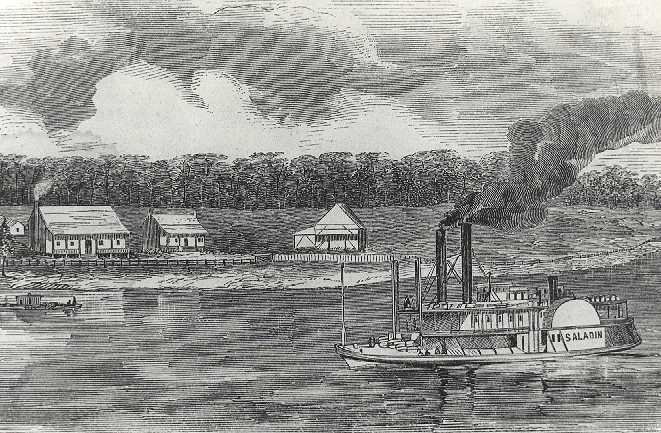
Etching of the Saladin on the New Orleans-to-Louisville line,
circa 1848
(University of Wisconsin-La Crosse).
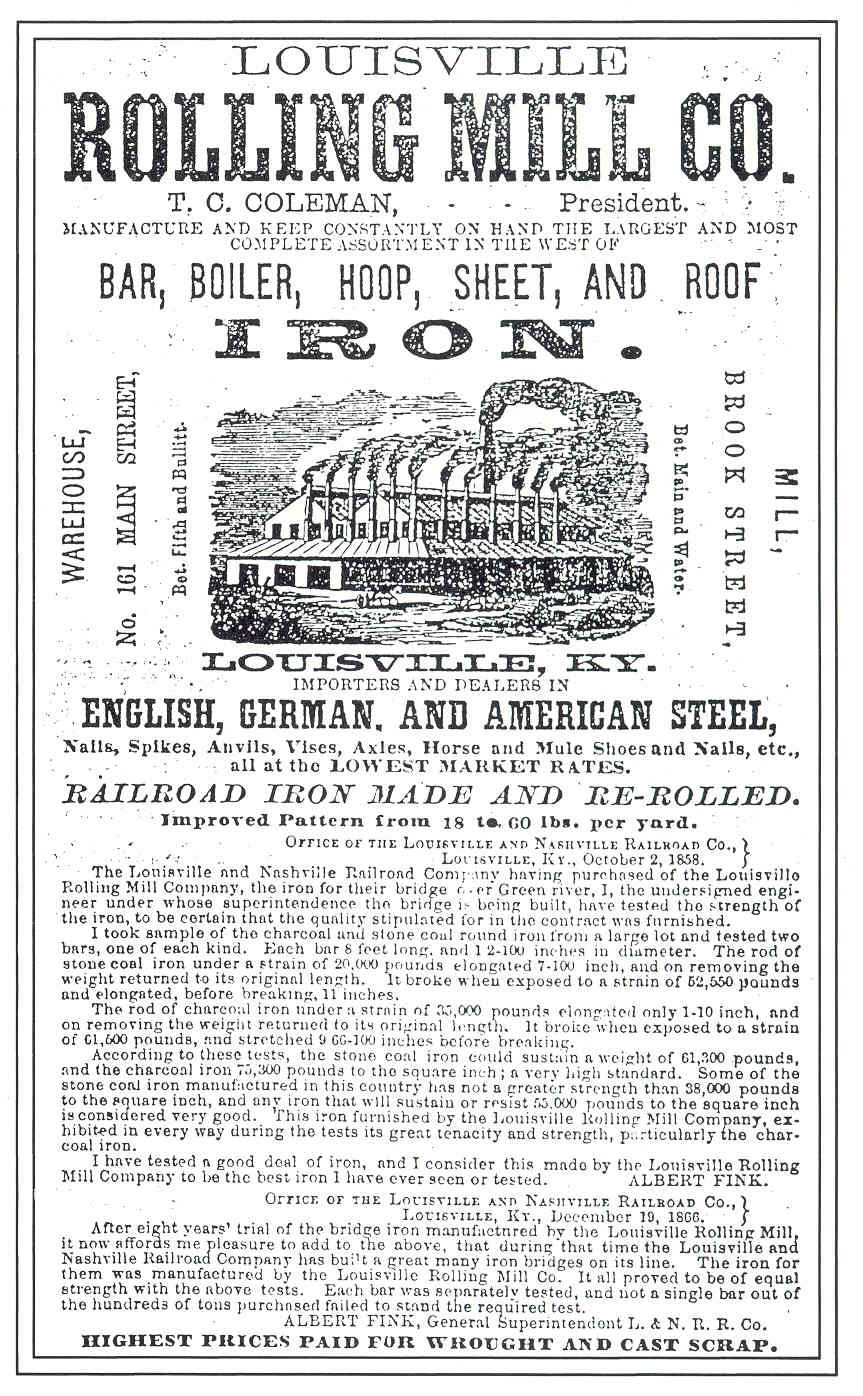
Newspaper advertisement for the Louisville Rolling Mill Company
(Thomas Cooper Coleman, President),
recently purchased by the
Louisville
and Nashville Railroad, providing
testimonial of L&N
general
superintendent Albert Fink as to the tested quality of
mill's iron bars
and rods
used in
the construction of the L&N
railroad bridge across
the Green River, dated 1866 (George Yater).
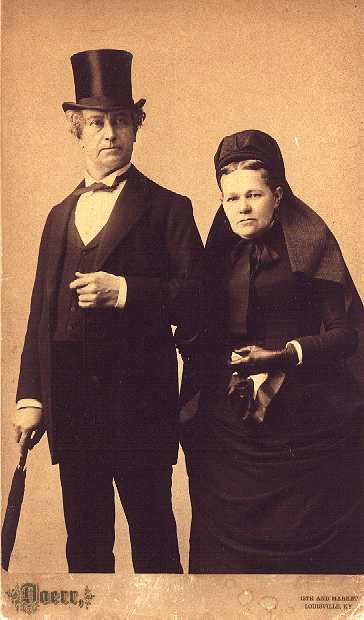
Thomas Cooper Coleman (1824-1901) and his wife
Dulcenia
Johnson Coleman, in 1886 (Dulcenia Straefer Wilder).
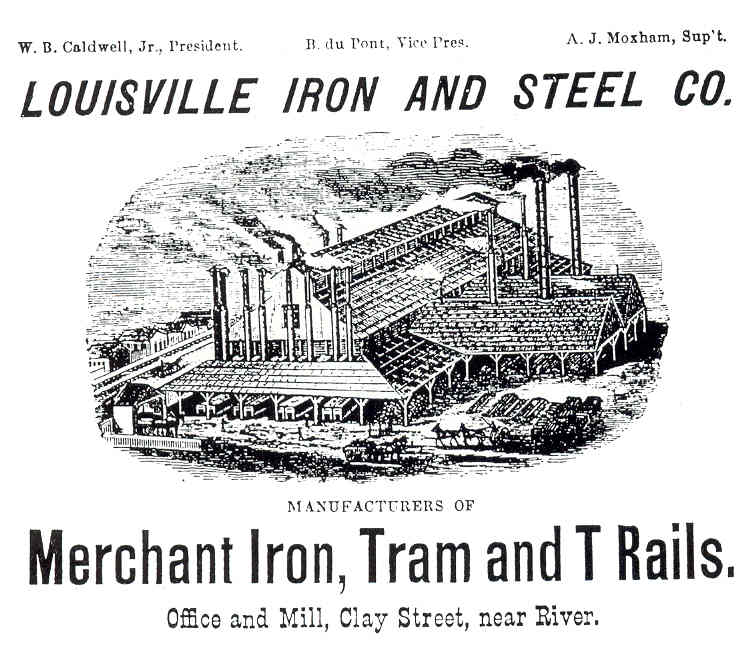
Directory advertisement of the Clay Street Mill of the Louisville
Iron and Steel
Company, noting
W. B. Caldwell, Jr., President, Bidermann du Pont, Vice President,
and A. J. Moxham, Superintendent (George Yater).
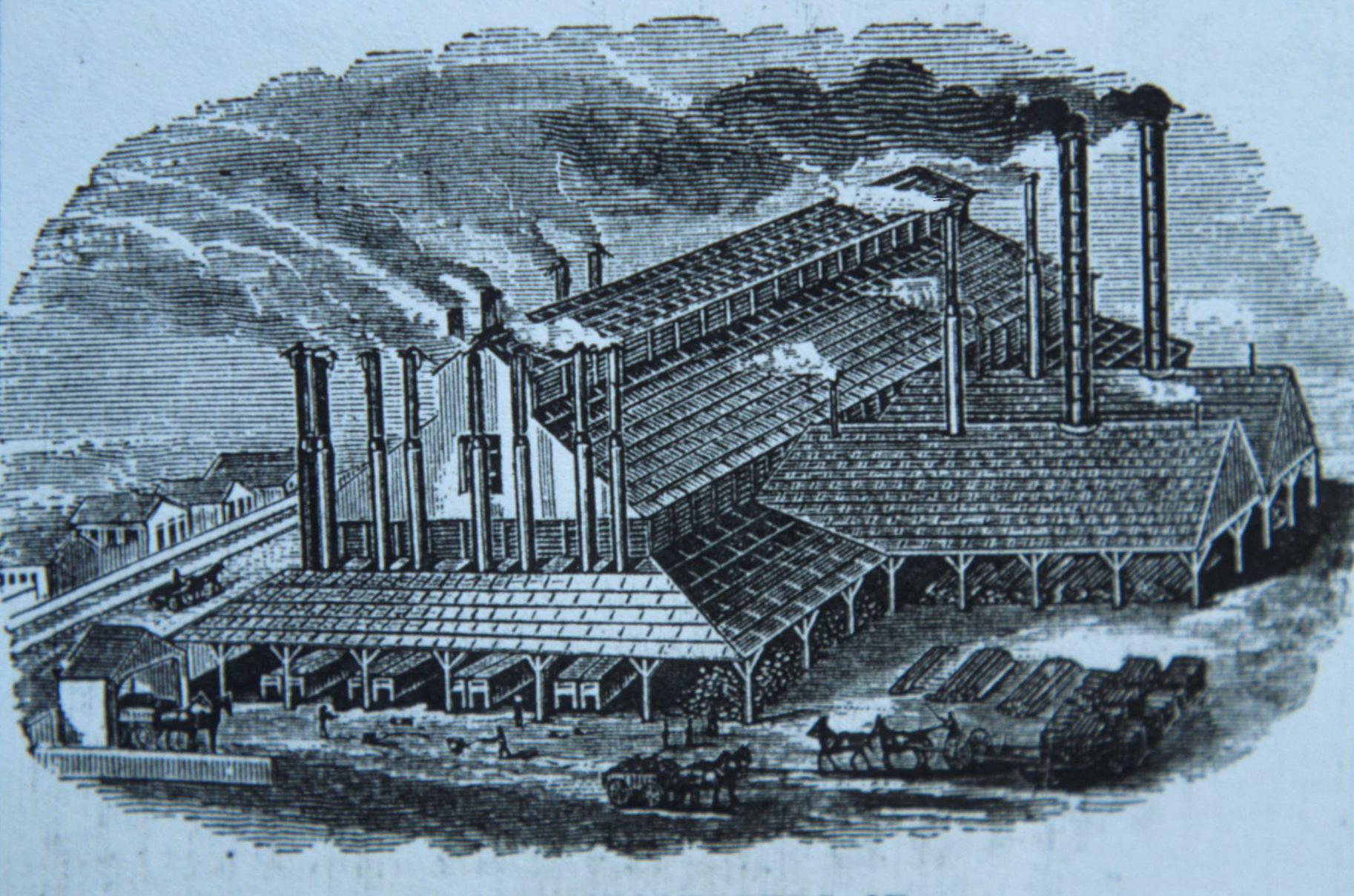
Detailed engraving from the above advertisement (AC).
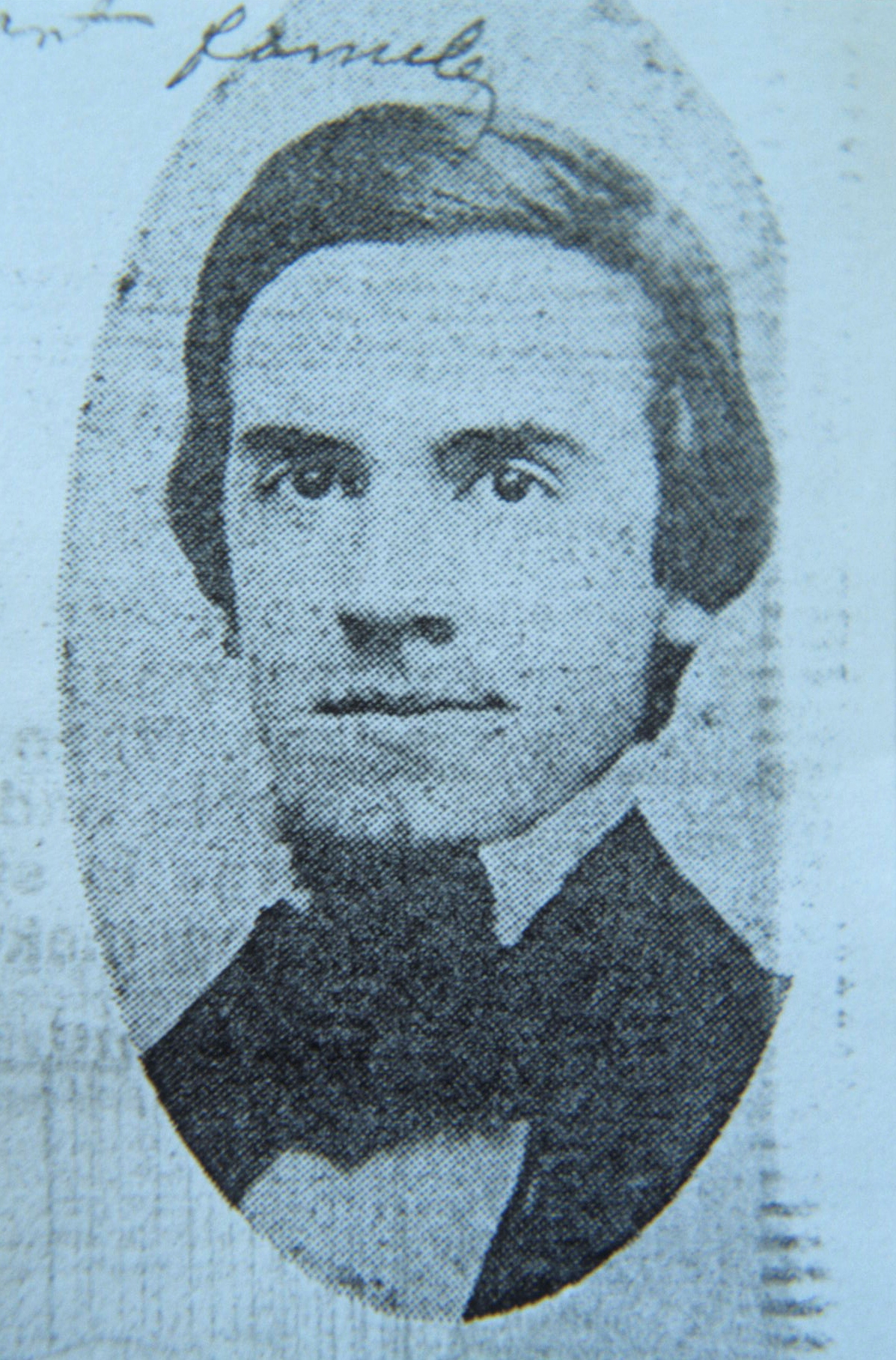
Alfred V. du Pont, circa 1856 (George Yater).
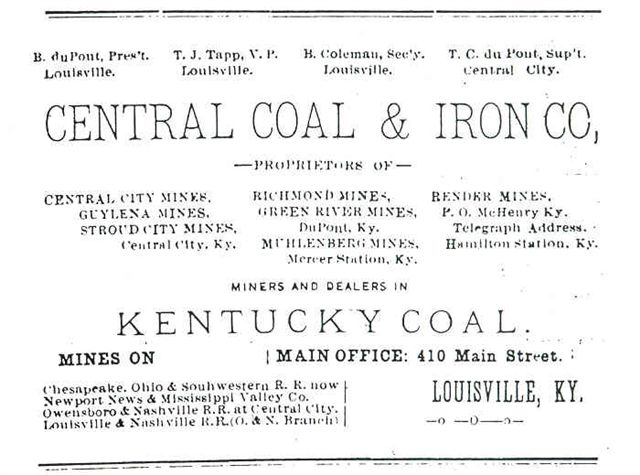
Directory advertisement for Central Coal & Iron Co, Louisville,
noting Bidermann du Pont,
President, and Thomas Coleman du Pont, superintendent at the Central City mines
(George Yater).
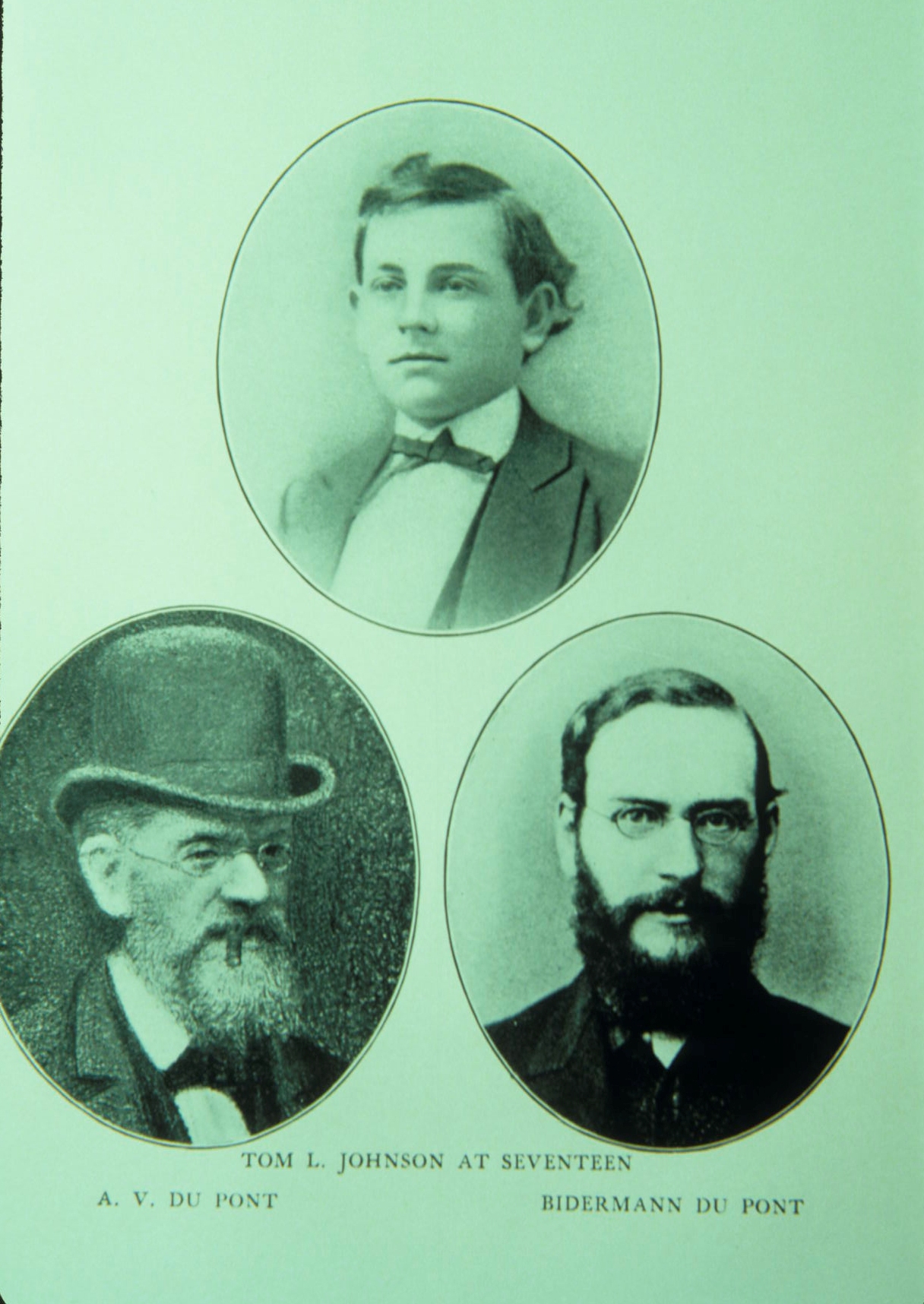
Tom L. Johnson, Alfred V. du Pont, and Bidermann du Pont,
circa
1871 (Tom L. Johnson, My Story, 1911).
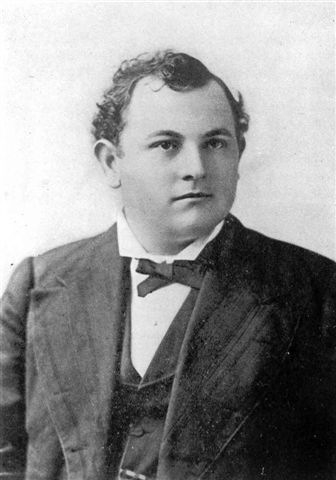
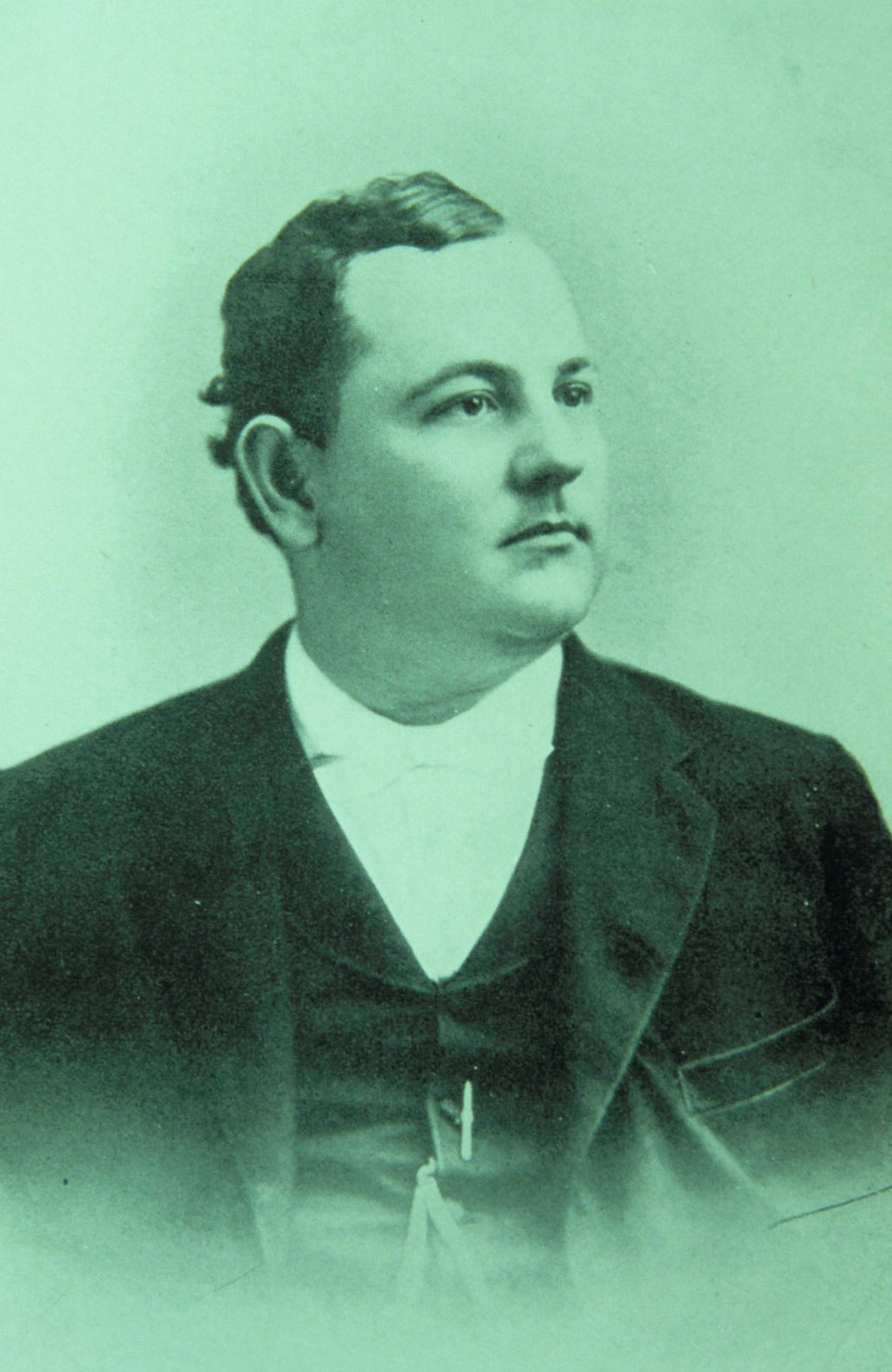
Tom L. Johnson in 1880 at age 26 and in 1886 at age 32
(Tom L. Johnson, My Story, 1911).
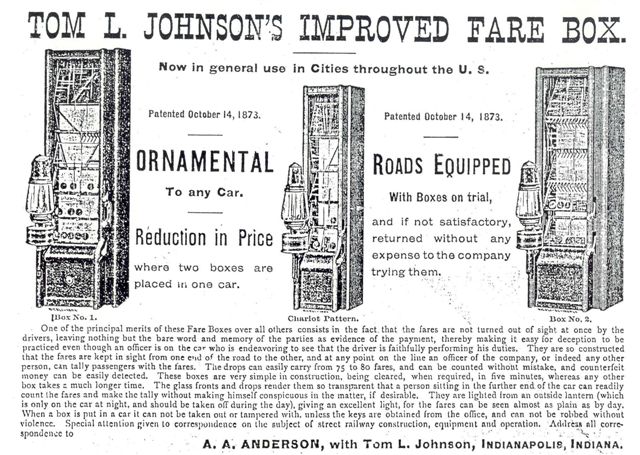
Advertisement for Tom Johnson's patented fare box.
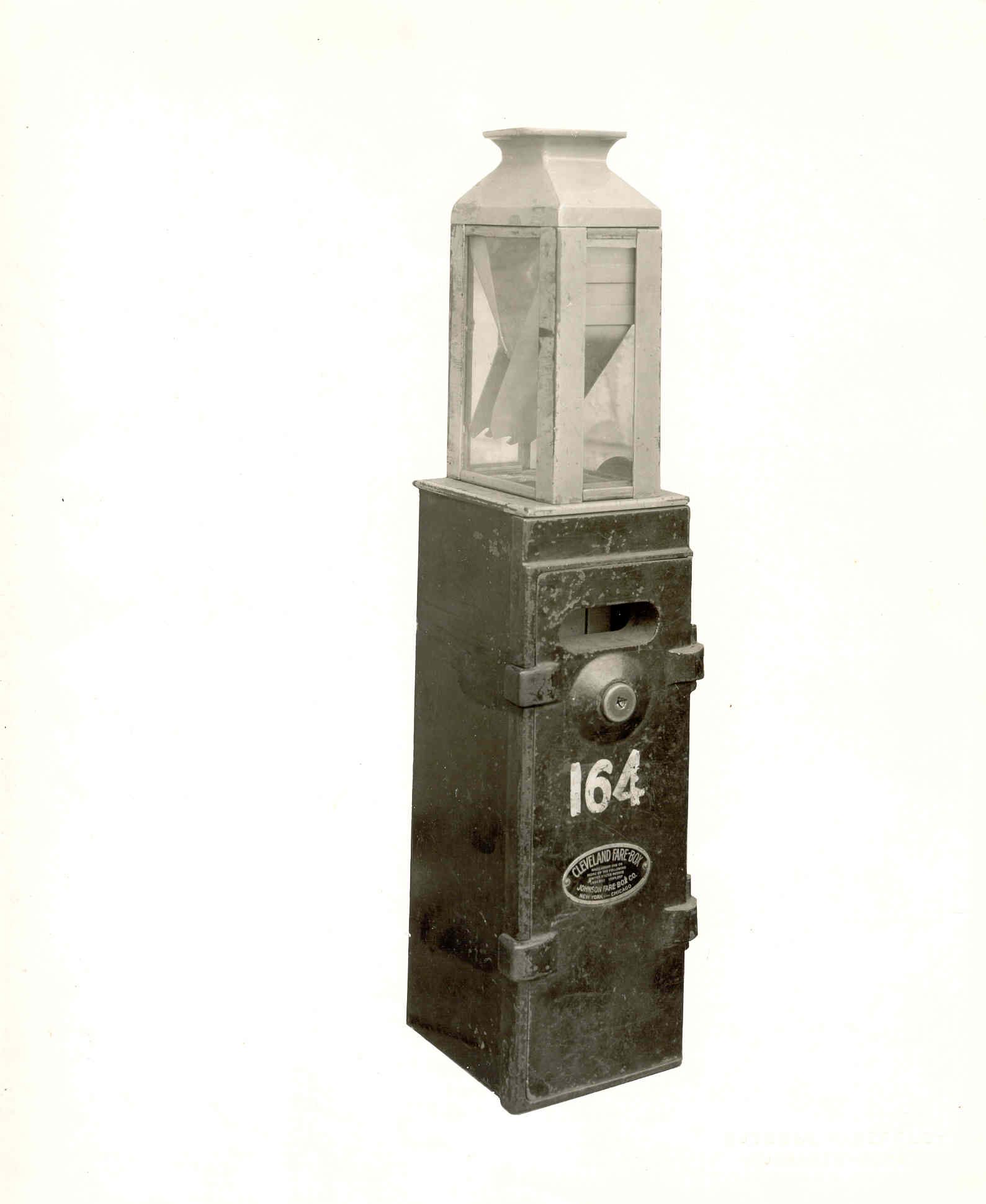
Cleveland Fare Box No. 164, product of the Johnson Fare Box
Co. (Harold Jenkins)
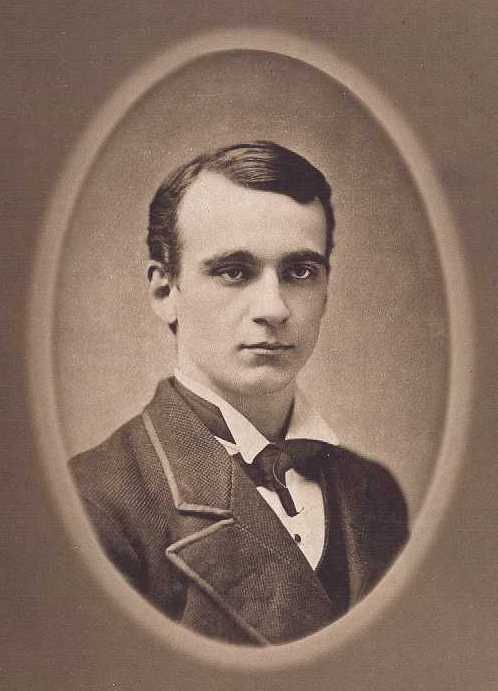
Arthur J. Moxham, 1876, possibly a wedding portrait
(Jim Moxham).
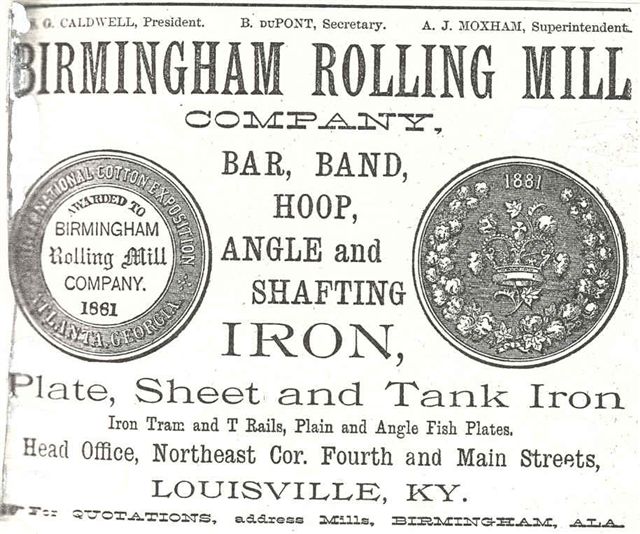
Advertising piece in the Kentucky State Gazette and Business Directory
1883-84 (George Yater).
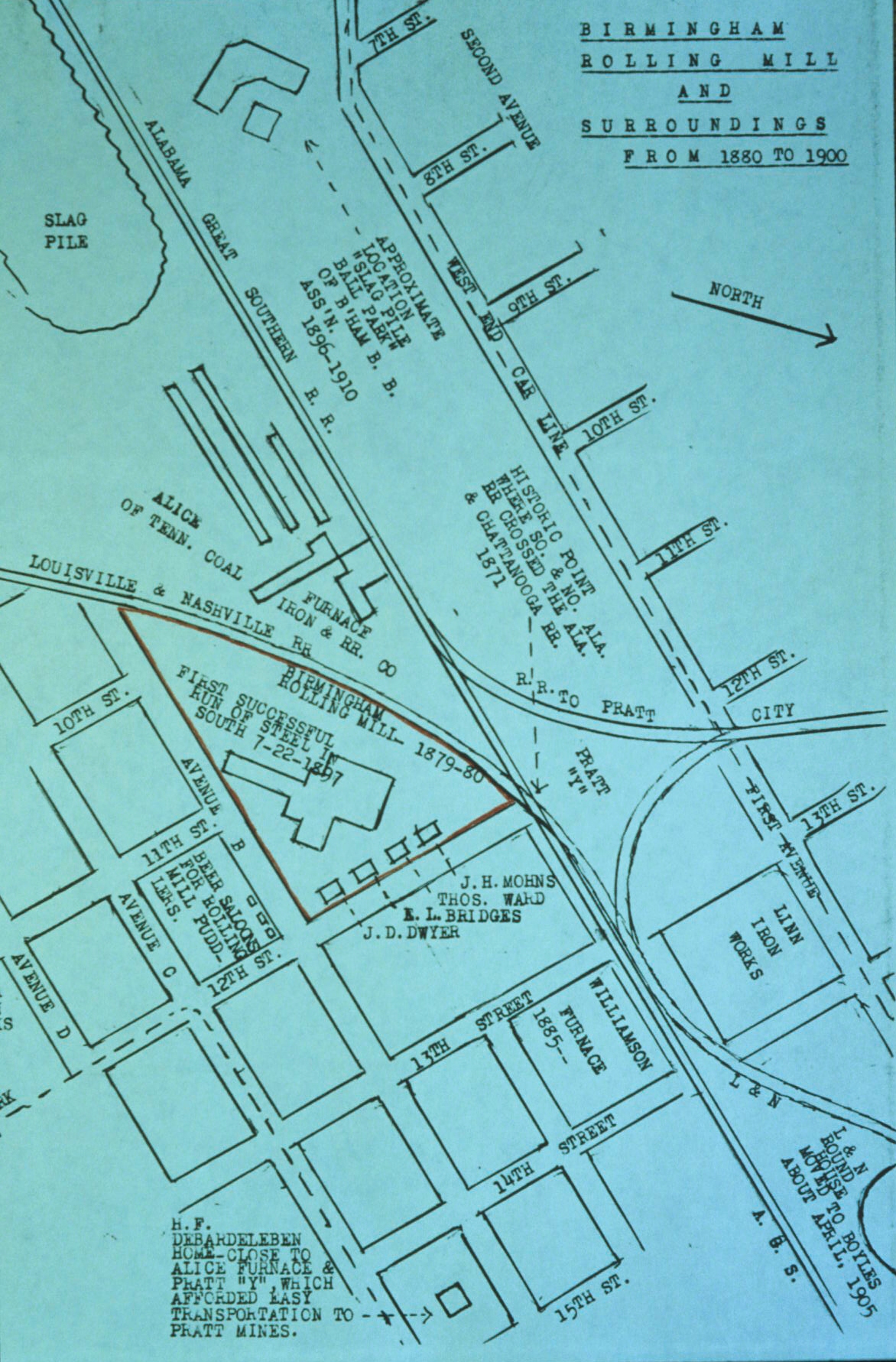
Reconstructed map of the Birmingham Rolling Mill, 1880-1900
(Birmingham Public Library).

Drawing of the Birmingham Rolling Mill, 1880s (Birmingham Public Library).
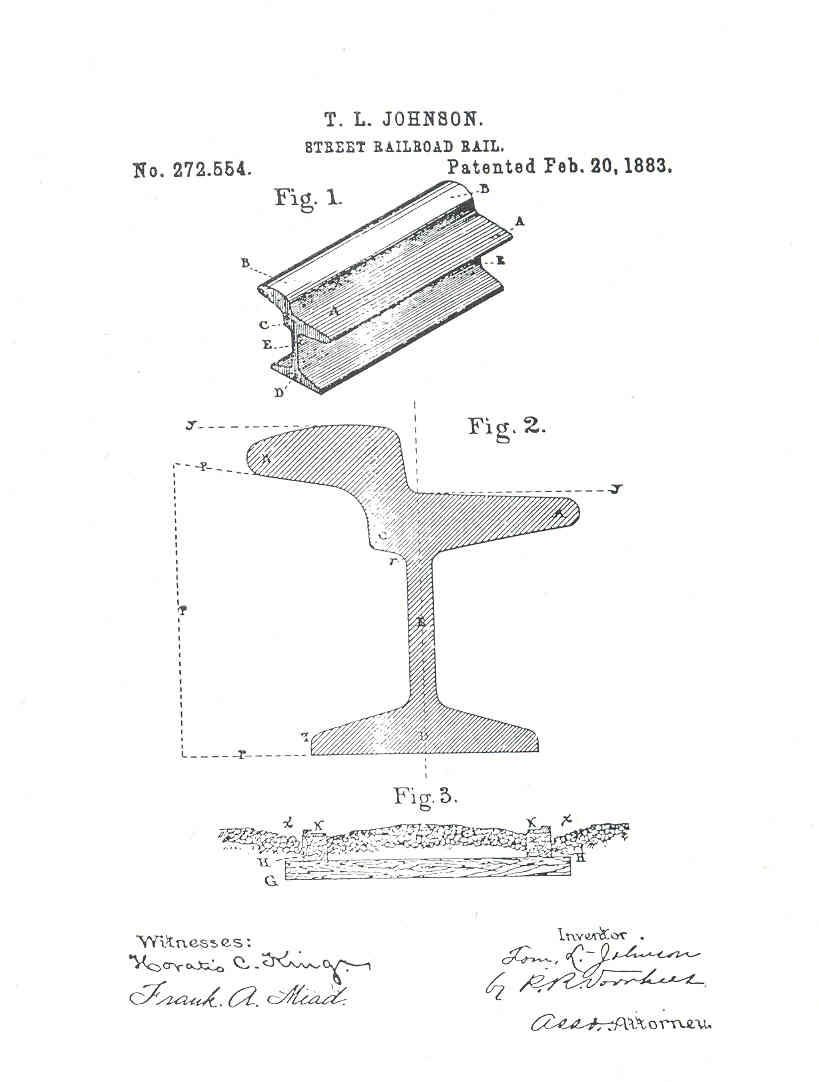
Tom L. Johnson patent no. 272,554 for the street railroad (girder or Jaybird)
rail, 1883.
(U. S. Government Patent Office).
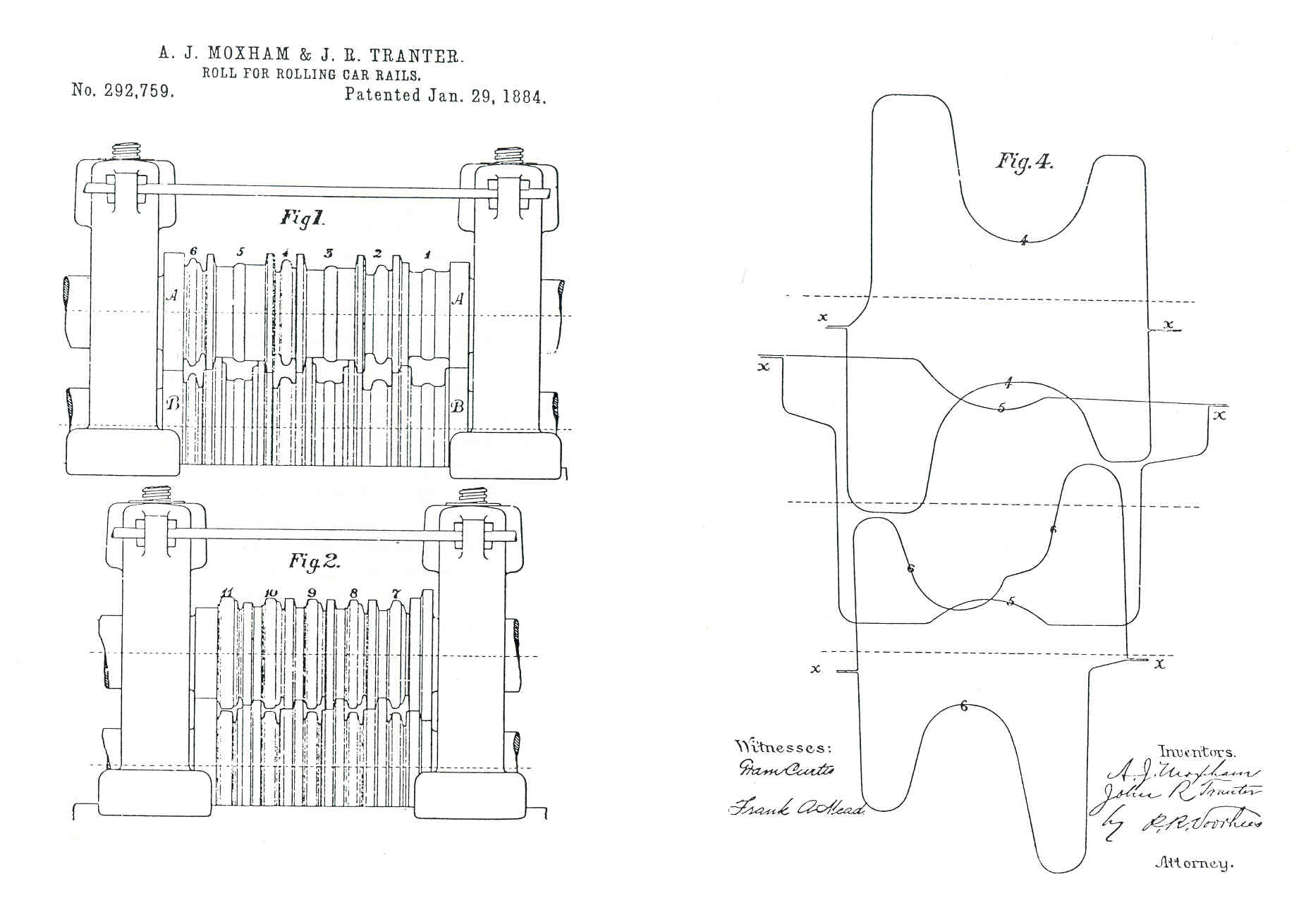
Patent no. 292,759 drawings for the Moxham and Tranter roll stand for
rolling the Johnson girder (Jaybird)
rail from
iron, 1884.
Hot steel blooms were set through a series of five roughing passes
(Fig. 1, nos. 1-5),
followed by the primary
forming
pass (no. 6) and five finishing passes (Fig. 2). The sectional drawings
illustrate
the estimated amount of reduction
and
forming accomplished in each pass. The patent claimed that the eleven
passes
could be completed without reheating the
bloom. After experimenting rolling this off-set flange sectional
from
iron at the Clay Street mill in Louisville in 1882,
Moxham concluded that the chemical composition of iron,
at various heats, would
not hold the design and resolved to roll it
from steel. At that time, there were few mills
with the capacity to roll odd
shapes from steel and would only contract to do so
during
slow production periods,
and the one that accepted Moxham's contracting was the
Cambria Iron Company in
Johnstown,
Pennsylvania.
At the same time, Moxham went ahead and patented his rolling
sequence, anticipating its success
using steel.
In practice, Moxham typically used a 26-inch three-high roll stand
(U.S. Government Patent Office).
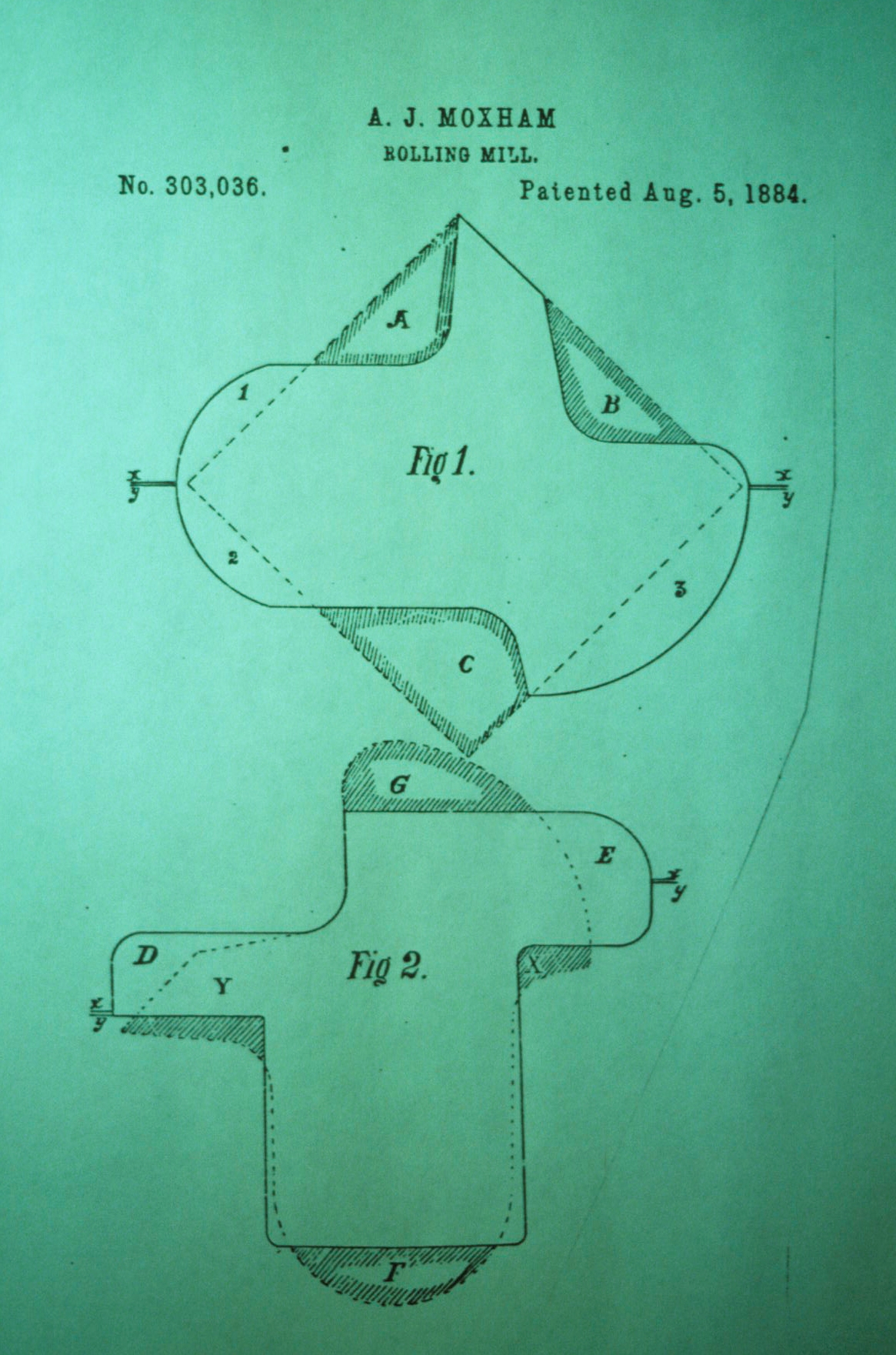
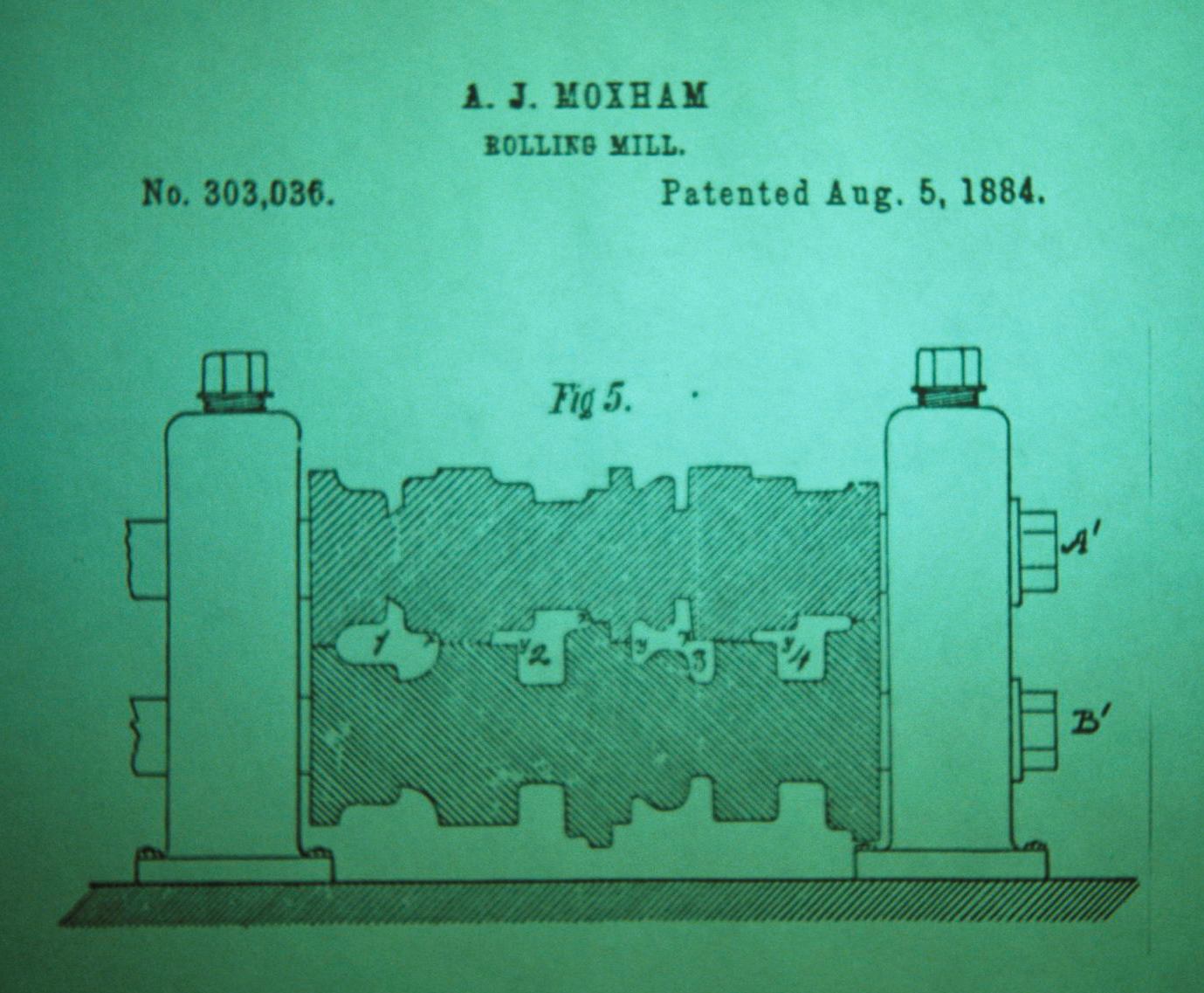
Arthur J. Moxham patent no. 303,036 for finishing passes for
rolling the off-set flanges of the
Johnson girder (Jaybird)
rail August 5, 1884
(U.S. Government Patent Office).
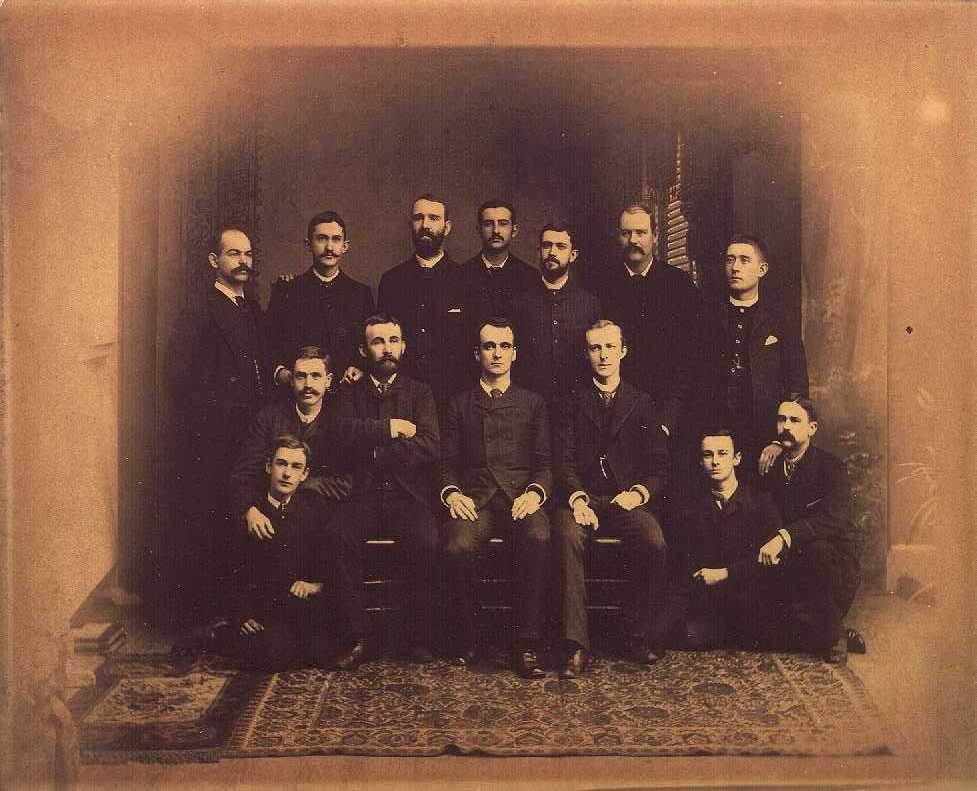
Officers and engineers of the Johnson Steel Street Rail Company,
Woodvale, Pennsylvania,
1886.
Standing are (from left): Clement F. Street, Lycergis G. Hopper, Mahlon
Kirkbride,
Robert Welch,
Francis H. Easby, Henry O'Shea, and William J. Murphy. Seated are: William
Glass, Louis Weiss,
Edward B. Entwisle, Arthur J. Moxham, Walter E. Hoppes, Rueben Glass,
Charles R.
Powell (JAHA).
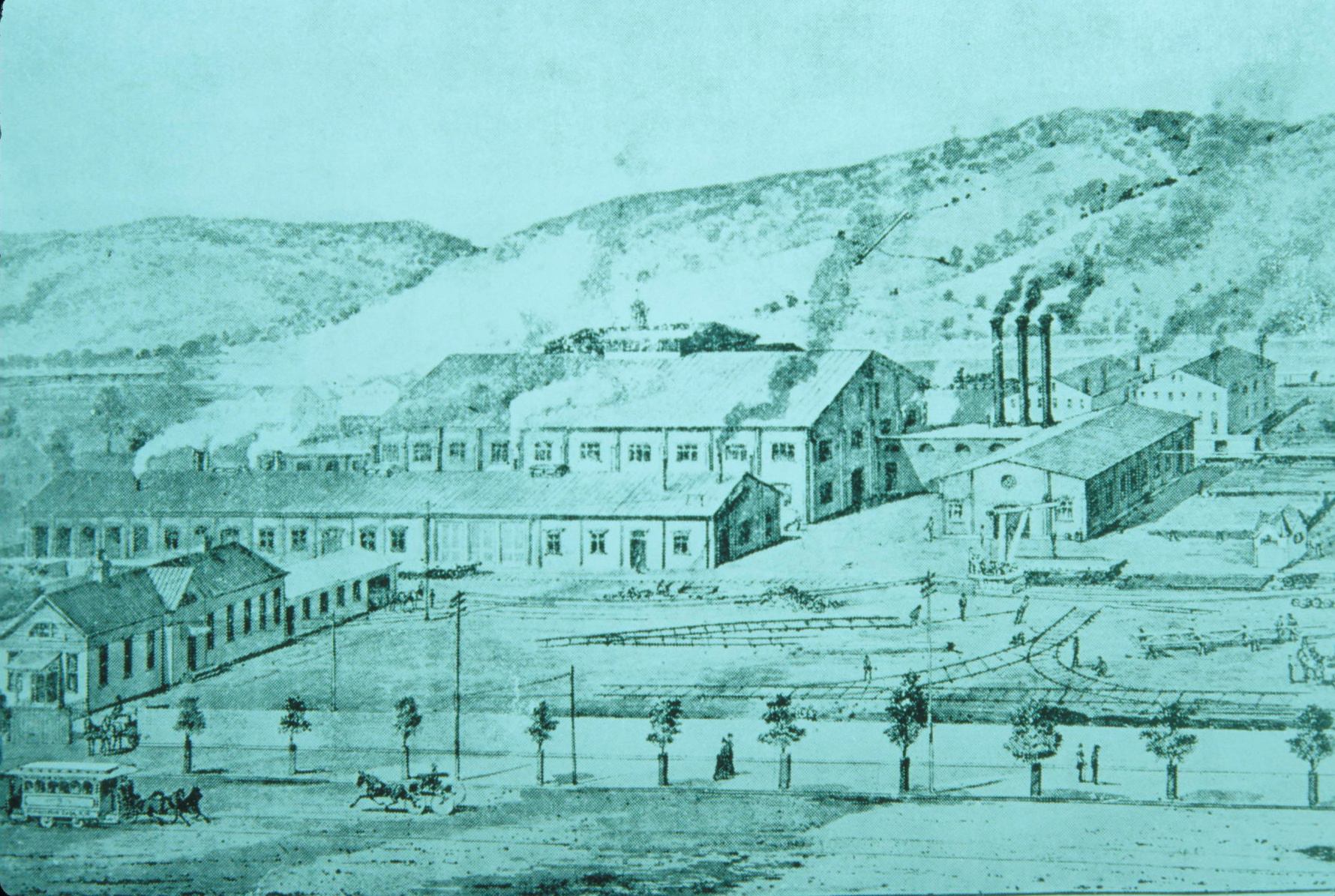
Artist's drawing of the Woodvale switch works, circa 1887,
looking south toward the Little Conemaugh
River
(behind the buildings).
In the foreground is a stylized portrayal of a horse-drawn car of the
Johnstown
Passenger
Railway Company,
running west along Maple Avenue toward the Gautier Wire
Works in Conemaugh
Borough.
This drawing and the two following were first published in the Johnson
Company
Catalog No. 6 (1888) (JAHA).
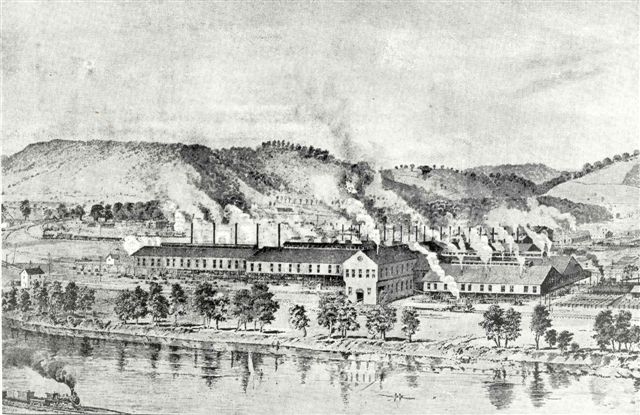
Artist's drawing of the Johnson Company Rolling Mill in Moxham,
completed in 1888, looking across
the
Stony Creek
toward the Town of Moxham. Though somewhat stylized, this impression accurately
portrays the
hills surrounding
Moxham and the tracks of the Johnstown and Stony Creek Railroad
(far left). The
railroad
engine depicted in the
immediate foreground on the east bank of the Stony Creek
could be on the line of
the
Baltimore and Ohio Railroad
which connected to the Pennsylvania Railroad and
maintained a freight station in
Conemaugh Borough and a
passenger station in Grubbtown (Osborne)
near the toll house of the Old Valley
Pike.
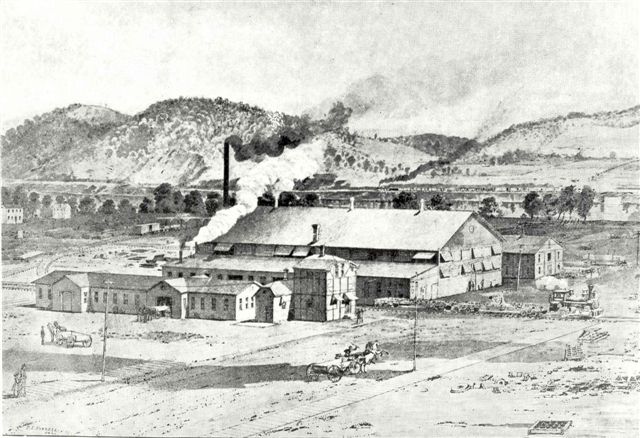
Artist's drawing of the Johnson Company's Mitis (Steel) Foundry
in Moxham, circa 1888, looking
west
from Central
Avenue and the Town of Moxham toward the Stony Creek in the background.
In this
impression the artist has left out
the rolling mill, which would have appeared directly
behind the
foundry and would have totally obscured the view of
the Stony Creek.
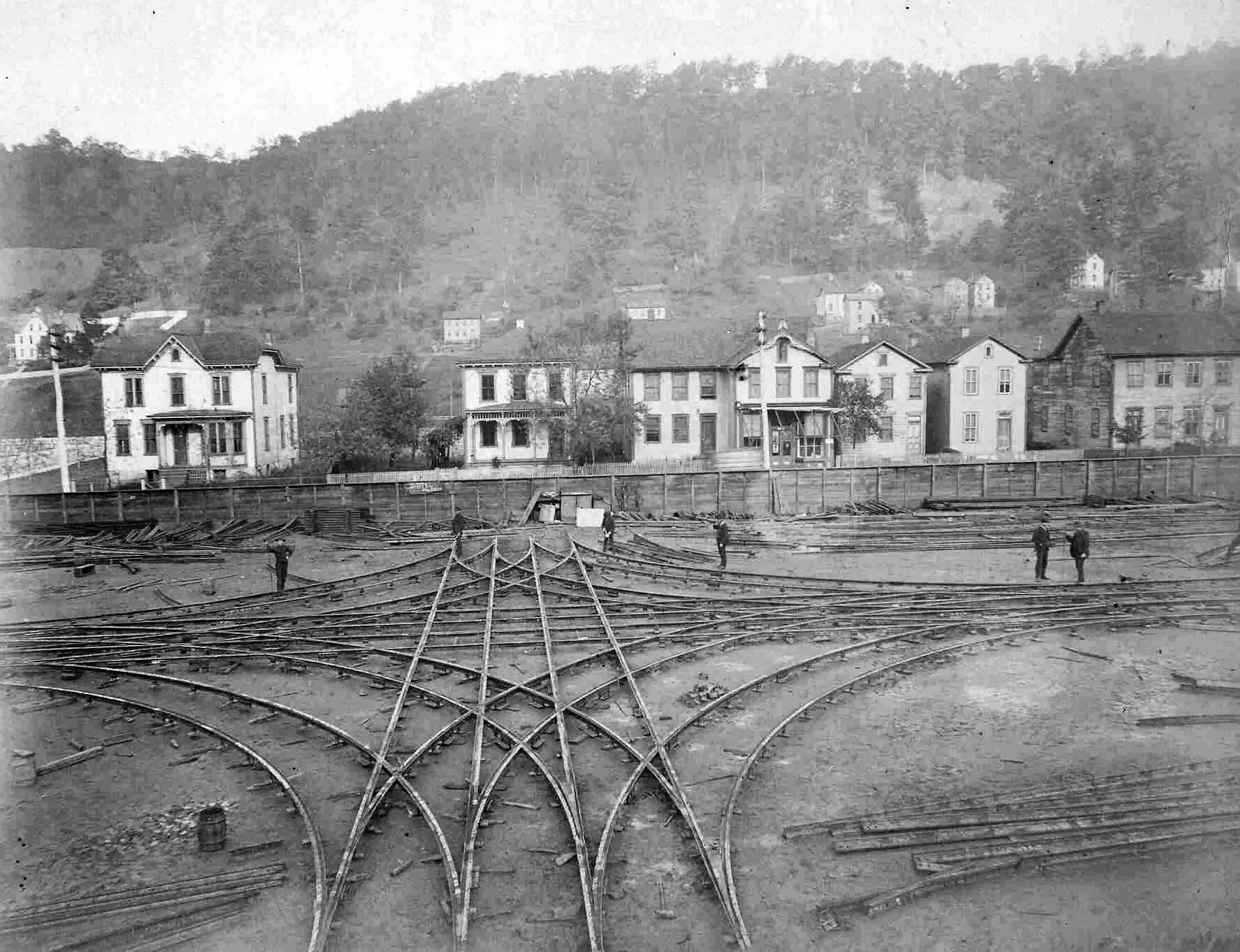
The laying out yard of the Woodvale switch works, spring 1889.
Across the fence (looking north)
are the residential houses on Maple Avenue between Fifth and Sixth Streets.
Yardmen are laying
out custom-designed double track, three-part Y curves with crossings for an
intersection of a
street railway line. Identified are (center-right): J. R. Darby, Edward Noble,
Jr. and (on the far
right)
Lycergis Hopper, R. P. Williams (JAHA).
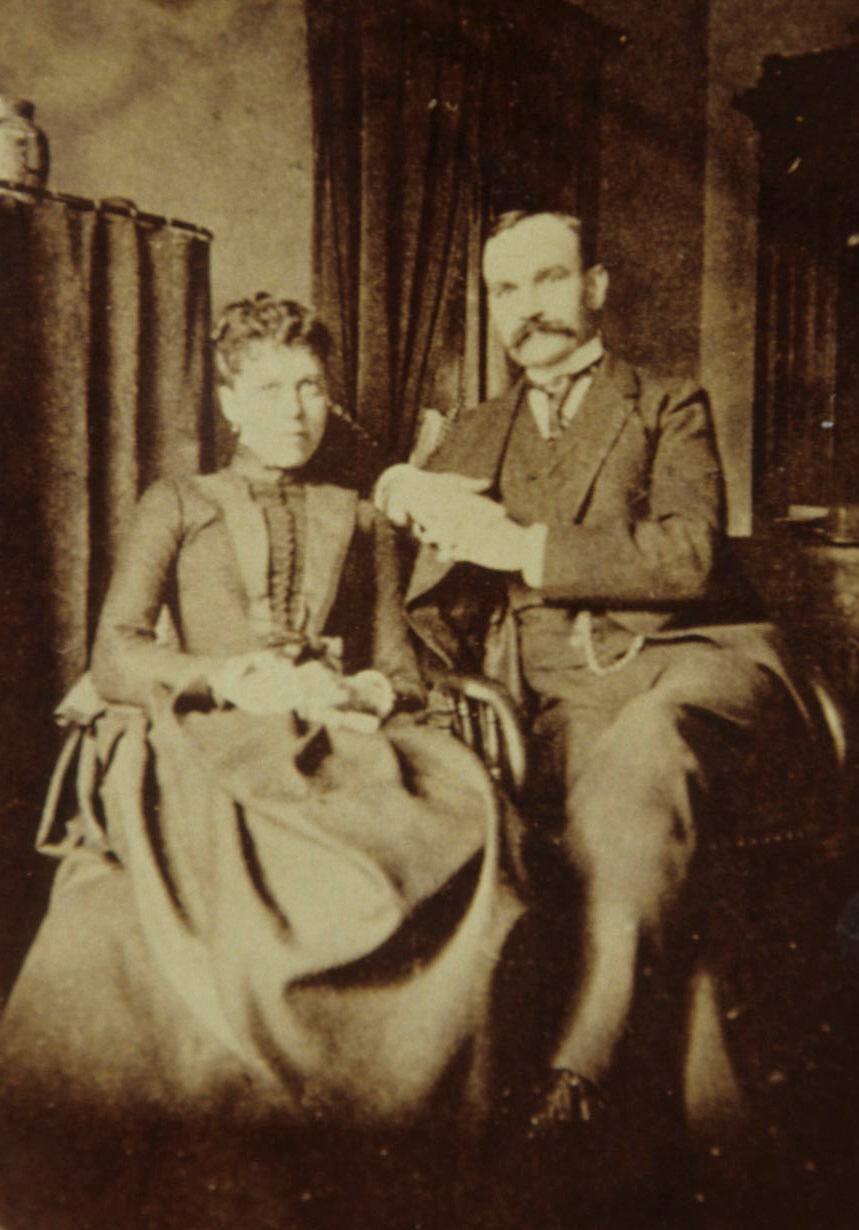
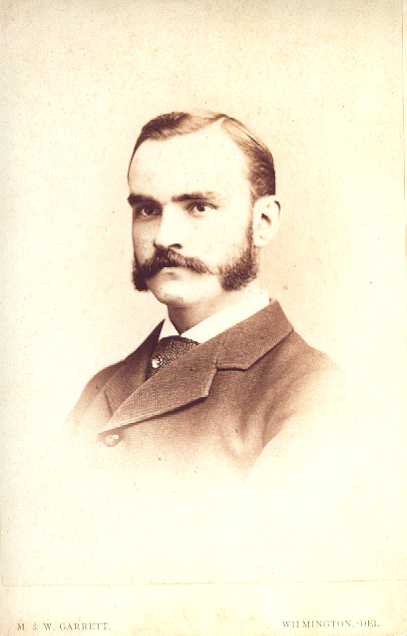
Charles Alfred Marshall and Dulcenia Coleman Marshall (sister of
Helen Coleman
Moxham),
portrait on left taken shortly after their marriage at The Meadows in
Louisville in October 1888.
Originally
from
Louisville,
Marshall apprenticed in
the rolling mills there and came to Johnstown after 1880
to
work
for the Cambria
Iron Company. He subsequently joined the Johnson Steel Street
Rail Company
in 1886
and worked at the Woodvale switch works. He designed and patented the
Marshall Clip,
a widely-adopted tie plate that allowed connection of rail sections onto
crossties
without bolts or rivets.
He was killed in the Great Flood in May1889, leaving his
wife and a young
daughter named after him (Dulcenia Straefer Wilder).
The Moxham family in residence at the Rosensteel House on Maple Avenue in Woodvale, Pennsylvania,
summer 1886. On the porch: Arthur J. Moxham holding daughter Dulcenia, wife Helen Moxham (seated),
and Moxham's sister Evangeline (Eva) and Helen's sister Dulcenia (Dellie). By the gate in the foreground:
Moxham's sons Thomas (left) and Egbert. Photograph by J. Morgan, Jr. (Jim Moxham).
Early photograph of a mule-drawn horse car of the Johnstown Passenger
Railway Company, Johnstown Pennsylvania, circa 1886 (Irving London)
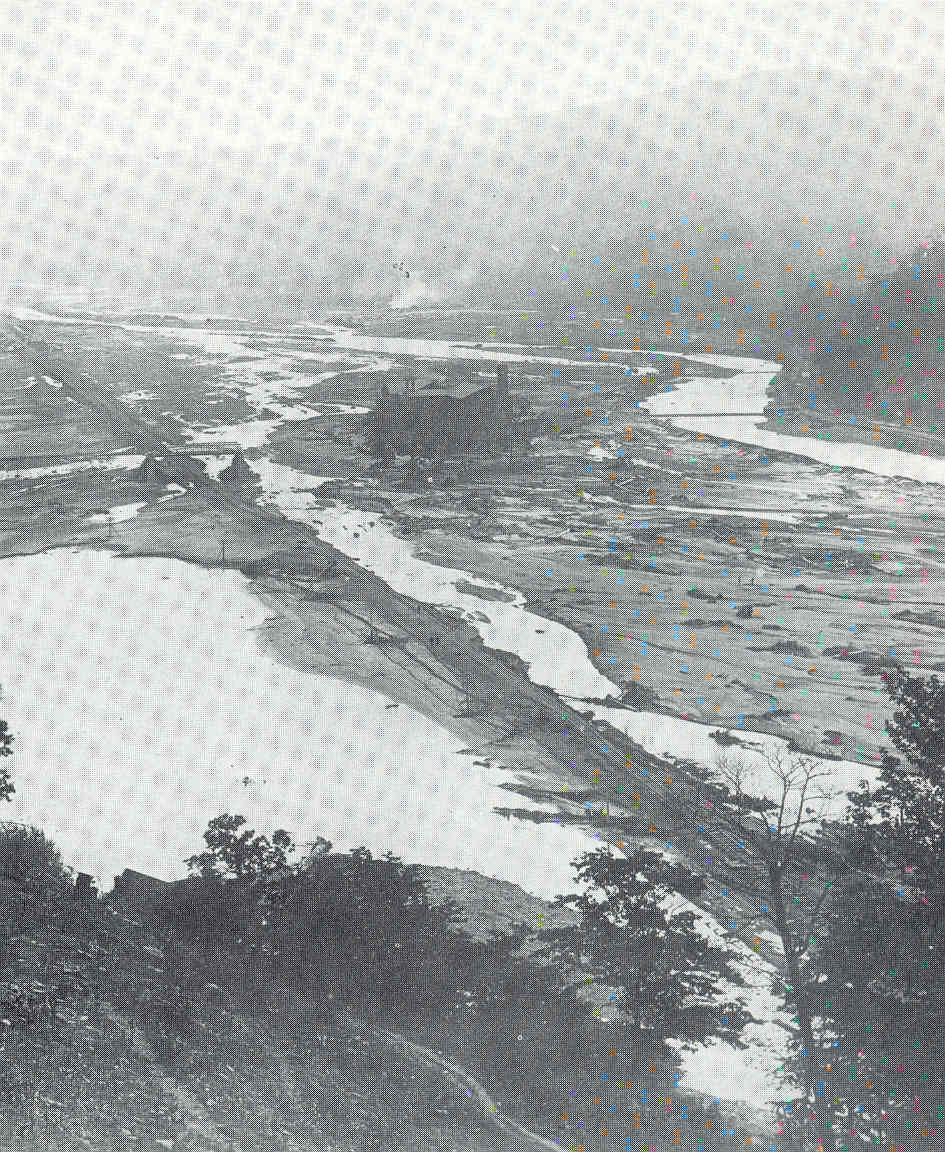
A community of over 1,200 persons, the Cambria Iron company town
of Woodvale,
adjacent to the Gautier Barbed Wire Works and straddling the Pennsylvania
Railroad,
was virtually swept away by the flood torrent, leaving only some buildings of
the
Johnstown Manufacturing Company's woolen mill (center) and the tracks of the
Pennsylvania and Cambria Iron Railroads (right foreground). Completely lost
were all residential buildings, woolen and flour mills, a chemical plant, the
entire
street railway car barns, cars, and stables, and the Johnson Company switch
works.
Much of the heavy machinery of the switch works was salvaged from the riverbed
and moved to the new mill site in Moxham (JAHA).
[go to Archive Part II - 1889-1929]
